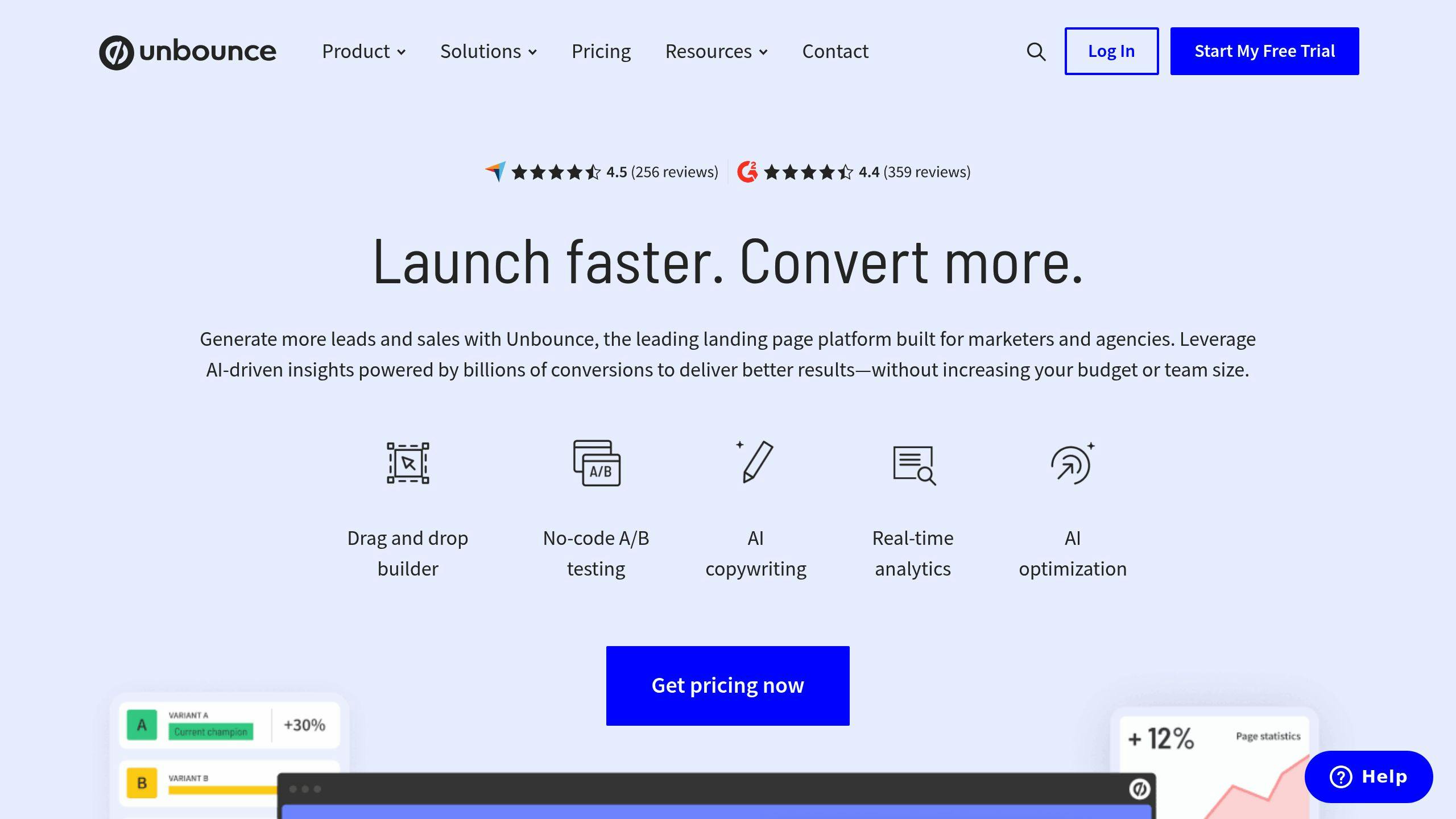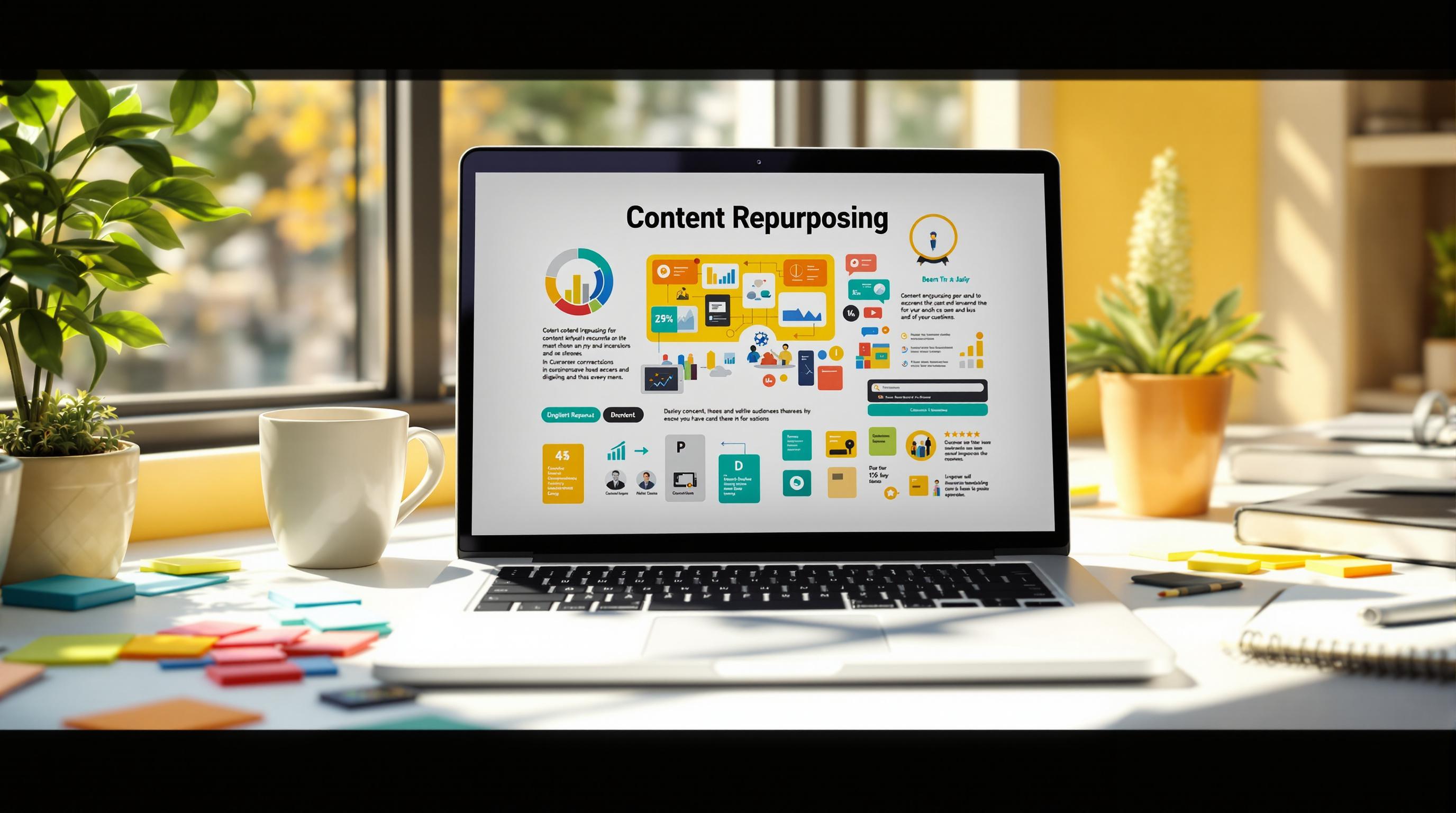Want to optimize your website's performance without coding? No-code A/B testing tools let you test, analyze, and improve your user experience quickly and easily. Here's what to look for and the top tools available:
Key Features to Look For:
- Visual Editors: Drag-and-drop functionality to create test variations.
- Advanced Targeting: Segment audiences by location, behavior, or device.
- Real-Time Analytics: Metrics and statistical insights to validate results.
- Third-Party Integrations: Seamless connection with tools like Google Analytics.
- Performance Impact: Tools optimized for speed and minimal site disruption.
Top No-Code A/B Testing Tools:
- Optimizely: Enterprise-grade platform for A/B and multivariate testing.
- VWO: User-friendly with heatmaps and visitor recordings.
- Google Optimize: Easy integration with Google Analytics (discontinued but alternatives exist).
- AB Tasty: Includes AI features like EmotionsAI and omnichannel testing.
- Unbounce: Focused on landing page optimization with Smart Traffic AI.
- Wrapifai: AI-driven testing for personalized UX experiments.
Quick Comparison:
| Tool | Best For | Starting Price | Key Features |
|---|---|---|---|
| Optimizely | Enterprise testing | Custom pricing | Multivariate, real-time insights |
| VWO | Behavior analysis | $154/month | Heatmaps, visitor recordings |
| AB Tasty | AI-powered optimization | $149.99/month | EmotionsAI, feature flags |
| Unbounce | Landing pages | $90/month | Smart Traffic, audience targeting |
| Wrapifai | AI element testing | Custom pricing | AI-driven UX experiments |
These tools make A/B testing accessible for businesses of all sizes, helping you improve conversions, reduce bounce rates, and create better user experiences - no coding required.
13 Best A/B Testing Tools to Improve Conversions
Must-Have Features in No-Code A/B Testing Tools
When choosing a no-code A/B testing platform to improve your website's user experience, certain features are crucial for success. Here's what to look for:
Visual Editor and Design Controls
A tool with a visual editor and drag-and-drop functionality allows you to create test variations without needing coding skills. Real-time previews are a must so you can see exactly how changes will appear to users before going live.
Advanced Targeting Capabilities
Your platform should allow audience segmentation based on factors like location, device type, user behavior, traffic source, and custom parameters. This ensures your tests are reaching the right audience.
Statistical Analysis and Reporting
Detailed statistical analysis is key. Look for tools that offer real-time metrics, significance testing, and revenue impact tracking to validate your results and make informed decisions.
| Feature Category | Key Components | Importance |
|---|---|---|
| Data Collection | Analytics integration, Event tracking, Heatmaps | Provides deep insights into user behavior |
| Testing Capabilities | A/B, Split URL, Multivariate testing | Supports a variety of testing approaches |
| Results Analysis | Statistical significance, Revenue tracking, Goal monitoring | Enables data-driven decisions |
Third-Party Integrations
Ensure the tool integrates seamlessly with your existing systems like analytics platforms, CRMs, and marketing tools. This simplifies data flow and enhances efficiency.
Quality Assurance Features
Good QA features are essential. Look for tools that offer preview testing, cross-browser compatibility checks, and mobile responsiveness validation to maintain a polished user experience.
Collaboration and Communication
Collaboration features like shared dashboards and easy result-sharing options help keep your team aligned and informed throughout the testing process.
Performance Impact
Choose tools that are optimized for performance. Features like asynchronous loading and CDN support ensure minimal impact on your website's loading speed.
When assessing these features, think about your team's specific needs and technical expertise. A tool with the right mix of capabilities will help you run effective A/B tests while keeping your website's user experience smooth.
Next, let’s dive into some of the top no-code tools that stand out in A/B testing.
1. Optimizely
Optimizely is a digital experience platform known for its A/B testing tools. Its drag-and-drop editor makes it easy for marketers and UX designers to set up tests without needing technical expertise.
Key Testing Capabilities
Optimizely supports both A/B and multivariate testing, allowing teams to experiment with multiple elements at once to find the best combinations for boosting user engagement.
| Feature | Capability | Benefit |
|---|---|---|
| Visual Editor | Drag-and-drop interface | Simplifies test creation, no coding needed |
| Statistical Analysis | Built-in significance testing | Reduces the risk of false positives |
| Mobile Testing | Cross-device optimization | Ensures smooth user experience on all platforms |
| Integration Options | Connects with third-party tools | Enables seamless data sharing |
Analytics and Performance Tracking
The platform offers real-time insights to help businesses make informed decisions. Its statistical engine handles sample size calculations and significance testing, ensuring accurate and reliable outcomes.
Features for Enterprises
- Advanced audience segmentation and real-time monitoring for detailed insights
- Round-the-clock customer support and extensive documentation
- High-level security measures for enterprise use
Forrester reports that Optimizely users see a 223% ROI over three years [2]. On Gartner Peer Insights, it has a 4.5/5 rating, praised for its user-friendly interface and robust features.
While Optimizely shines with its enterprise-grade capabilities, other tools may better suit specific needs.
2. VWO (Visual Website Optimizer)

VWO is an A/B testing platform that blends powerful tools with a user-friendly, no-code approach. Its visual editor makes it easy for marketers and UX designers to set up and run tests without needing to code.
Testing Capabilities
VWO's visual editor simplifies creating test variations, making it a great option for teams without technical skills. The platform supports various testing methods to improve website user experience.
| Testing Type | Use Case | Key Benefit |
|---|---|---|
| A/B Testing | Compare two page versions | Simple setup for basic tests |
| Multivariate | Test different element combinations | Find the best-performing features |
| Split URL | Test entirely different pages | Ideal for redesign evaluations |
Advanced Features
VWO includes tools like heatmaps and visitor recordings to analyze user behavior. These insights help teams make informed decisions to improve site performance.
Integration and Analytics
VWO works seamlessly with tools like Google Analytics. Its real-time reporting lets teams track test results and adjust strategies based on data.
Targeting and Segmentation
The platform allows teams to define test segments based on factors like device type, location, or traffic source. Real-time monitoring shows how different groups respond to variations, helping teams refine their approach quickly.
Enterprise Support
For larger organizations, VWO offers extensive support across channels. It also ensures high security standards and provides detailed documentation to help teams get the most from their testing efforts.
While VWO is excellent for in-depth testing and behavior analysis, other tools like Google Optimize may be better suited for specific needs.
3. Google Optimize
Google Optimize was a no-code A/B testing tool that worked seamlessly with Google Analytics, making it easy for businesses of all sizes to run experiments without needing coding skills.
Core Capabilities and Integration
This platform combined essential testing methods with advanced analytics integration:
| Test Type | Purpose | Best For |
|---|---|---|
| A/B Testing | Compare two page versions | Simple design adjustments |
| Multivariate | Test multiple elements together | Complex page changes |
| Redirect Tests | Compare different web pages | Full page redesigns |
Its tight integration with Google Analytics allowed users to align tests with Analytics goals and audiences. This meant businesses could track and analyze their tests in detail. The tool used Bayesian statistical methods to determine results, though test reports often took up to 12 hours to refresh.
Platform Features
Google Optimize came with several useful tools, including:
- A visual editor for building test variations
- Integration with Analytics goals for better tracking
- Audience segmentation using Analytics data
- Real-time monitoring of experiments
- Built-in statistical analysis to measure outcomes
Although it was a solid choice for basic testing, businesses that needed more advanced options often turned to premium tools with stronger personalization and testing features.
Looking Forward
With Google Optimize no longer available, there are other A/B testing tools that offer similar capabilities. These alternatives provide unique features to help businesses refine their user experience and improve website performance. Let’s dive into another leading option in this space.
sbb-itb-c495ab1
4. AB Tasty

AB Tasty offers a user-friendly platform packed with advanced testing tools designed to refine digital experiences. Its features make it possible for teams to make data-backed decisions without needing technical expertise.
Core Testing and Deployment Features
| Feature | What It Does | Why It Matters |
|---|---|---|
| EmotionsAI | Tracks visitor emotional responses | Helps create emotion-based audience segments |
| Feature Flags | Manages feature rollouts | Enables gradual launches and quick rollbacks |
| Omnichannel Testing | Runs tests across various platforms | Ensures a seamless experience on all devices |
The EmotionsAI feature helps identify how users feel during their visit, allowing teams to tailor test variations based on emotional insights [1]. Feature Flags streamline feature deployment by supporting gradual rollouts, server-side testing, real-time monitoring, and instant rollbacks - minimizing risks while improving results [1].
Multi-Platform Testing
AB Tasty works across:
- Desktop websites
- Mobile apps
- Connected devices
- Other digital touchpoints
This ensures tests are consistent and reliable, no matter where users interact with your brand [1]. These tools help teams focus on creating user-centered improvements that boost overall site performance.
For those looking for a mix of modern tools and ease of use, AB Tasty is a strong choice. Next, let’s dive into another no-code A/B testing solution.
5. Unbounce

Unbounce is a go-to platform for teams zeroing in on landing page improvements. Instead of optimizing entire websites, it focuses on fine-tuning individual landing pages, making it a standout choice in the no-code A/B testing space.
Core Testing Capabilities
| Feature | Description | Benefit |
|---|---|---|
| Landing Page Builder | Drag-and-drop editor for creating and testing landing page variations. | Quickly deploy test-ready variants. |
| Performance Analytics | Provides instant feedback on landing page performance. | Helps refine elements for better results. |
| Advanced Targeting | Tools for audience segmentation. | Gain precise control over who sees what. |
| Comprehensive Testing | Offers split URL and multivariate testing options. | Flexibility to test across various scenarios. |
Platform Features and Integration
Unbounce connects seamlessly with tools like Google Analytics, HubSpot, and Salesforce, giving you a full picture of your testing outcomes. Its standout feature, Smart Traffic, uses AI to direct visitors to the top-performing landing page variations. This approach often delivers better results than traditional A/B testing methods.
Pricing and Value
Plans start at $90/month, with pricing based on visitor volume and features. It’s a mid-range option, but its focus on landing page testing and intuitive interface makes it a solid pick for marketing teams aiming to boost conversions.
While Unbounce shines at landing page optimization, it’s worth noting that some other tools are better suited for A/B testing across entire websites.
6. Wrapifai

Wrapifai isn’t your typical A/B testing platform. Instead, it brings an AI-driven approach to UX experimentation, working alongside traditional A/B testing tools. This platform focuses on testing how AI components influence user experience, adding a new layer to your testing strategy.
Core Capabilities and Applications
| Feature | Function | Testing Application |
|---|---|---|
| AI Tool Creation | Build custom AI-driven elements | Compare AI-driven tools with static content |
| Performance Tracking | Monitor AI component performance | Analyze engagement metrics for AI elements |
| Custom Branding | Align AI elements with site design | Ensure consistent UX during testing |
| Easy Embedding | Simple integration of AI tools | Deploy test variations without coding |
Wrapifai allows teams to experiment with AI-driven features - like personalized recommendations or interactive tools - against traditional, static alternatives. Key features such as performance tracking and branding customization make it easier to measure engagement and conversion rates tied to AI variations.
Integration and Testing
To fully leverage Wrapifai, you’ll need to pair it with a standard A/B testing platform for traffic splitting. Wrapifai itself focuses on creating and analyzing AI-driven elements, making it an excellent companion tool for more traditional testing setups.
Best Use Cases
Wrapifai shines in scenarios like:
- Dynamic Content: Comparing AI-generated recommendations with static content.
- User Experience: Testing AI-powered personalization against conventional designs.
- Engagement Tools: Evaluating interactive AI features versus static alternatives.
This platform is ideal for teams exploring AI in UX design. By combining Wrapifai with traditional A/B testing tools, you can gain deeper insights into how AI elements impact user behavior and engagement.
Picking the Right A/B Testing Tool
Choosing the right A/B testing tool means finding one that fits your organization’s specific needs, technical skills, and budget. Here’s a breakdown of what to consider.
Skill Level Assessment
First, look at your team’s technical expertise. Some tools are beginner-friendly with easy-to-use interfaces, while others, like SiteSpect, are built for teams with advanced technical knowledge [1]. Match your team’s skill set to the complexity of the tool to avoid unnecessary challenges.
Testing Requirements Analysis
Different tools cater to different testing needs. Here’s a quick comparison:
| Testing Need | Recommended Tools | Key Features |
|---|---|---|
| Basic A/B Testing | Google Optimize, Unbounce | Simple setup and essential features |
| Multivariate Testing | VWO, Optimizely | In-depth statistical analysis |
| AI-Powered Testing | AB Tasty, Unbounce Smart Traffic | Automated test optimization |
| Enterprise-Scale Testing | SiteSpect, Adobe Target | Scalable with advanced functionality |
Budget and Traffic Considerations
Your budget and website traffic are critical factors. For example, VWO starts at $154/month for up to 10,000 users [3], while Unbounce begins at $112/month [1]. FigPii offers a free plan for up to 15,000 visitors per month, with paid plans starting at $149.99. To ensure accurate results, aim for at least 5,000 visitors and 1,000 conversions per variation.
Integration Capabilities
Make sure the tool works well with your existing systems, like analytics platforms, CRM tools, and marketing automation software. A smooth integration will save time and reduce disruptions to your workflow.
"Affordable options can meet your testing needs without requiring premium tools." - Uwemedimo Usa, Conversion Copywriter
Support and Resources
Check what kind of support the tool offers, such as:
- Tutorials and guides
- Responsive customer service
- Help with setup and implementation
- Active user communities for troubleshooting
Performance Impact
Website speed is a big deal during A/B testing. Tools that slow down your site can hurt user experience and skew your results. Pick one that offers powerful features but keeps performance issues to a minimum. Balancing functionality with speed is key to successful testing.
Conclusion
No-code A/B testing tools have reshaped how teams approach user experience optimization. These platforms make it possible for teams, regardless of their technical skills, to make data-driven decisions without needing to write a single line of code. From basic testing needs to advanced AI-driven features, there's something for everyone.
Our analysis of top platforms highlights how tools like Optimizely and VWO provide advanced testing options, while simpler solutions like Google Optimize serve as great starting points for smaller teams. By blending AI with no-code functionality, these tools allow teams to achieve powerful testing results without technical hurdles [1][3].
Here’s a quick look at which tools suit different needs:
| Testing Scale | Recommended Solution |
|---|---|
| Small Business | Google Optimize |
| Mid-Market | AB Tasty/VWO |
| Enterprise | Optimizely |
Platforms like AB Tasty bring automation into the mix with features such as EmotionsAI and Feature Flags, which simplify testing while minimizing risks [1]. On the other hand, Unbounce's Smart Traffic uses AI to fine-tune landing page performance, making it a standout option for focused testing.
These tools are also tackling common challenges. For example, AB Tasty’s AI features help reduce the time and sample size needed for tests, making advanced optimization more accessible to a wider range of organizations.
With the rise of AI-powered capabilities, A/B testing is becoming faster and more precise. Many platforms now integrate seamlessly with existing workflows and analytics tools, allowing teams to implement testing strategies more easily and efficiently.
For businesses aiming to enhance their digital presence, no-code A/B testing tools offer a practical way to adopt data-driven optimization strategies without facing technical roadblocks. These tools are paving the way for smarter, more accessible user experience improvements.
FAQs
What is the best tool for A/B testing?
Choosing the right A/B testing tool depends on your business size, budget, and technical needs. Here's a breakdown to help you decide:
| Business Size | Recommended Tool | Key Features |
|---|---|---|
| Enterprise | Optimizely | Multivariate testing, AI-driven optimization |
| Mid-Market | AB Tasty | EmotionsAI, omnichannel testing |
| Small Business | Google Optimize | Easy to use, free tier available |
| E-commerce Focused | VWO | E-commerce-specific features, visual editor |
When evaluating tools, keep these factors in mind:
Integration and AI Capabilities: Many tools now integrate smoothly with existing systems and use AI for tasks like visitor segmentation and automated optimization. For example, AB Tasty and VWO are known for their strong AI features [1].
Scalability: If your business is growing, tools like Optimizely can support advanced needs such as multivariate testing and feature flagging [1]. These features are crucial for scaling your testing efforts effectively.
Real-Time Analytics: Tools that provide instant insights, like Unbounce, allow teams to quickly identify which variations perform best, helping you make faster decisions [3].
Pricing Models: Some platforms offer custom pricing tailored to your business, while others have tiered subscriptions based on traffic or features [1]. Always weigh your budget against the tool's capabilities to find the best fit.


